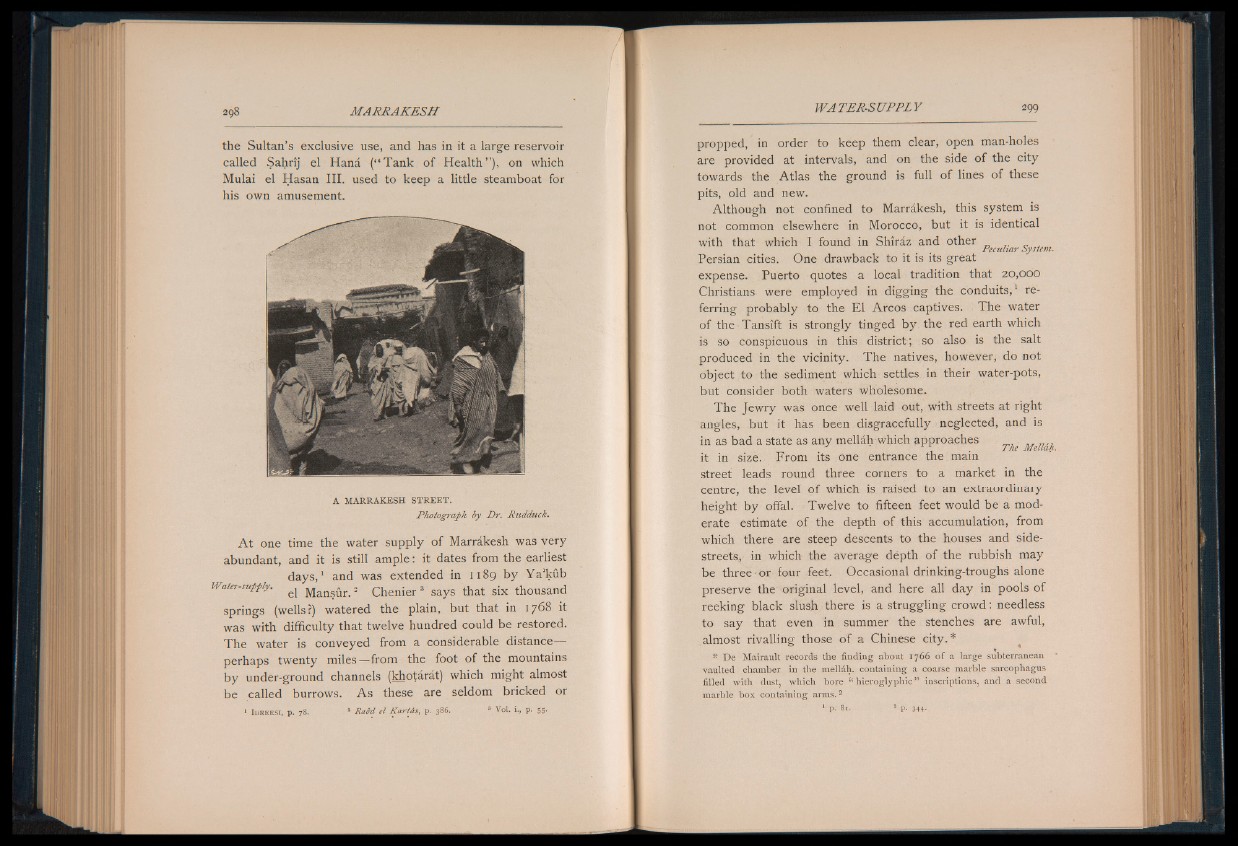
the Sultan’s exclusive use, and has in it a large reservoir
called Sahrij el Hana (“ Tank of Health” ), on which
Mulai el Hasan III. used to keep a little steamboat for
his own amusement.
A MARRAKESH STR E E T .
Photograph by Dr. Rudduck.
A t one time the water supply of Marrakesh was very
abundant, and it is still ample: it dates from the earliest
day s,1 and was extended in 1189 by Y a ’kub
Water-supply. ^ Mansur.2 Chenier 3 says that six thousand
springs (wells ?) watered the plain, but that in 1768 it
was with difficulty that twelve hundred could be restored.
The water is conveyed from a considerable distance—
perhaps twenty miles— from the foot of the mountains
by under-ground channels (khotarat) which might almost
be called burrows. A s these are seldom bricked or
1 I d r e e s i , p . 7 8 . 2 R a b d e l K a r t & s , p . 3 86 . 3 V o l . i. , p . 5 5 .
propped, in order to keep them clear, open man-holes
are provided at intervals, and on the side of the city
towards the Atlas the ground is full of lines of these
pits, old and new.
Although not confined to Marrakesh, this system is
not common elsewhere in Morocco, but it is identical
with that which I found in Shiraz and other Peculiar ¡system.
Persian cities. One drawback to it is its great
expense. Puerto quotes a local tradition that 20,000
Christians were employed in digging the conduits,1 referring
probably to the El Arcos captives. The water
of the Tansift is strongly tinged by the red earth which
is so conspicuous in this district; so also is the salt
produced in the vicinity. The natives, however, do not
object to the sediment which settles in their water-pots,
but consider both waters wholesome.
The Jewry was once well laid out, with streets at right
angles, but it has been disgracefully neglected, and is
in as bad a state as any mellah which approaches Melldh
it in size. From its one entrance the main
street leads round three corners to a market in the
centre, the level o f which is raised to an extraordinary
height by offal. Twelve to fifteen feet would be a moderate
estimate of the depth of this accumulation, from
which there are steep descents to the houses and side-
streets, in which the average depth of the rubbish may
be three ■ or four feet, Occasional drinking-troughs alone
preserve the original level, and here all day in pools of
reeking black slush there is a struggling crowd: needless
to say that even in summer the stenches are awful,
almost rivalling those of a Chinese city.*
* De Mairault records the finding about 1766 of a large subterranean
vaulted chamber in the melldh. containing a coarse marble sarcophagus
filled with dust, which bore “ hieroglyphic” inscriptions, and a second
marble box containing arms.2
| p . 8 1 . I P - 344-